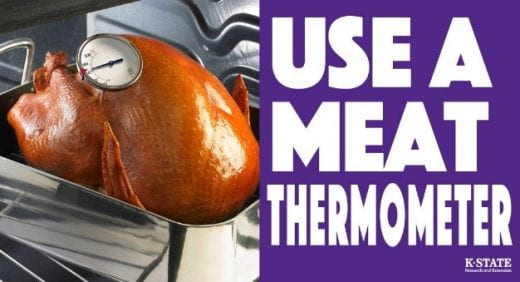 Always wash your hands, utensils, the sink, and anything else that comes into contact with raw turkey and its juices with soap and water.
Always wash your hands, utensils, the sink, and anything else that comes into contact with raw turkey and its juices with soap and water.
Safe thawing:
Buy your fresh turkey 1 or 2 days before you plan to cook it. If you are buying frozen, keep frozen until you’re ready to safely thaw. As a general rule when thawing in the refrigerator, allow approximately 24 hours for every 4 to 5 pounds of turkey. For example, a 20-pound turkey will take 5 to 6 days to thaw. Keep the turkey in its original wrapper and place on a tray or in a pan to catch any juices that may leak while in the refrigerator. A thawed turkey can remain in the refrigerator for 1-2 days and if necessary, a turkey that has been properly thawed in the refrigerator can be refrozen. For safe thawing in cold water and the microwave learn more here: https://www.fsis.usda.gov/shared/PDF/Lets_Talk_Turkey.pdf
Safe roasting: 
Set your oven temperature no lower than 325 °F and place your turkey on a rack in a shallow roasting pan. Stuffing a turkey is not recommended; for more even cooking, add stuffing outside the bird in a casserole. The stuffing and turkey must reach a safe internal temperature of 165° F. Check the internal temperature in the innermost part of the thigh and wing and the thickest part of the breast. For personal preference, you may choose to cook turkey to higher temperatures. Do not rely on the “pop-up” indicator, double check with a food thermometer. For quality, let the turkey stand for 20 minutes before carving. Below is a chart for the recommended roasting times according to the USDA.
Safe leftovers:
Discard any turkey, stuffing, and gravy left out at room temperature longer than 2 hours; 1 hour if temperatures are above 90ᵒ F. Divide leftovers into smaller portions and refrigerate or freeze in covered shallow containers for quicker cooling. Use leftover refrigerated turkey within 3-4 days and if freezing leftovers, use within 2-6 months for best quality. Reheat turkey and stuffing to an internal temperature of 165° F.
For more information, please visit the USDA’s Let’s Talk Turkey consumer guide https://www.fsis.usda.gov/shared/PDF/Lets_Talk_Turkey.pdf.
By: Ashley Svaty

 Join us in Beloit on February 28, 2020 to find answers to your questions about selling goods, sales tax, and food safety, for all types of products. Cost to attend the workshop will be $20, which includes lunch.
Join us in Beloit on February 28, 2020 to find answers to your questions about selling goods, sales tax, and food safety, for all types of products. Cost to attend the workshop will be $20, which includes lunch. Always wash your hands, utensils, the sink, and anything else that comes into contact with raw turkey and its juices with soap and water.
Always wash your hands, utensils, the sink, and anything else that comes into contact with raw turkey and its juices with soap and water.
 The Food and Drug Administration has updated their advice in regards to consuming fish while pregnant, breastfeeding, young children, and women planning to become pregnant. While the concern about consuming mercury is still valid, the advice now includes the importance of consuming fish as part of a healthy diet.
The Food and Drug Administration has updated their advice in regards to consuming fish while pregnant, breastfeeding, young children, and women planning to become pregnant. While the concern about consuming mercury is still valid, the advice now includes the importance of consuming fish as part of a healthy diet. Follow the suggestions below to Fight BAC!® (foodborne bacteria) and reduce the risk of foodborne illness this summer.
Follow the suggestions below to Fight BAC!® (foodborne bacteria) and reduce the risk of foodborne illness this summer. The message continues. Do not use electric pressure cookers for canning. Research conducted at Utah State University shows that electric pressure cookers do not always reach or sustain safe temperature levels for safe canning. This is even more critical at higher altitudes.
The message continues. Do not use electric pressure cookers for canning. Research conducted at Utah State University shows that electric pressure cookers do not always reach or sustain safe temperature levels for safe canning. This is even more critical at higher altitudes.